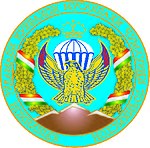Tajik Mobile Forces
The Mobile Forces are the paratroopers of the armed forces of Tajikistan. They are similar to the Russian Airborne Troops, whom they often train with. The Mobile Forces act as a special forces in Tajikistan, subservient to the Defense Ministry.
| Mobile Forces of the Ministry of Defense of Tajikistan | |
|---|---|
 The honour guard of the Mobile Forces at the Kohi Milat in 2014. | |
| Founded | 2002 (as part of the Tajik National Army)[1] 2005 (as a separate branch) |
| Country | |
| Branch | |
| Type | Paratroopers |
| Role | Counterterrorism, special forces |
| Size | 20,000 |
| Part of | |
| Headquarters | Dushanbe International Airport |
| Nickname(s) | Tajik Special Forces |
| Anniversaries | Paratroopers' Day (August 4) |
| Commanders | |
| Commander of the Mobile Forces | Major General Mirali Rahmatzoda |
| Notable commanders | Major General Latif Fayziyev |
| Insignia | |
| Identification symbol |  |
Although they are called paratroopers, the Mobile Forces often deployed out of helicopters, as the Tajik Air Force has few fixed wing aircraft.
History
.jpg)
In 2002, the Mobile Forces performed drills with special forces units from France, at Dushanbe International Airport. It led to the two nations planning greater military cooperation in the future.
A three-day joint training operation took place on 14 September 2006, known as Interaction 2006, with the Mobile Forces and the People's Liberation Army of China. The operation trained Chinese and Tajik troops in counter terrorism, crisis response, and strengthening the countries' capability of facing new threats. The training took place in the northern Khatlon province, at the Mumirak military base. The operation had two stages. The first included preparations for interactions between the two countries. The second focused on joint counter terrorism operations at the Mumirak range.
On 4 August 2007, the Ministry of Defence created a Paratroopers' Day to celebrate the Mobile Forces. A war game demonstration was held in Fakhrobod, some 30 kilometers south of Dushanbe, in which a Mobile Forces sub unit took part in taking out a terrorist group and freeing hostages. The war game was attended by senior officials of the Ministry, as well as other officers, politicians, and veterans of the Soviet invasion of Afghanistan.
In 2009, another war game occurred at Fakhrobod, this time led by instructors of the French Air Force. Using French aircraft, some 50 Mobile Forces and National Guard soldiers practiced parachuting from airplanes. In late 2011, France trained more paratroopers of the Tajik Military Institute, Mobile Forces, and National Guard. They jumped from C-160 aircraft.
On 27 September 2011, Tajikistan and Kyrgyzstan signed the plan of bilateral military cooperation for 2012 on the sidelines of the ongoing joint military exercise. Commander of the Mobile Forces, Major General Latif Fayziyev, was in overall command of the ongoing war game. A joint military exercise for subunits of the armed forces of Tajikistan and Kyrgyzstan as well as special police unit of Tajikistan was launched in the Tajik eastern Jirgatol district, Rasht Valley. The exercise scenario is based on surrounding a group of international terrorists in one of mountain gorges in Jirgatol on the Tajik-Kyrgyz border.
Another large group of international terrorists attempts to penetrate into Tajikistan from neighboring country to help the surrounded terrorists. Tajikistan and Kyrgyzstan launch a joint operation to annihilate the terrorists. The exercise that involved more than 600 servicemen of the Mobile Forces, National Army, and Border Troops and special police unit of the Interior Ministry's office for Rasht Valley as well as the operational group of Kyrgyzstan's Ministry of Defense along with armored vehicles and combat helicopters closed with a final phase featuring live-fire missions.
Later in 2012, the Mobile Forces performed training with the Collective Security Treaty Organization in the Chelyabinsk Oblast of Russia. A mountain company of the Mobile Forces as well as the special group of the Ministry of Defense took part in the war game. It ended in August 2012.[2]
Structure
- 7th Airborne Assault Brigade
- Motorized rifle brigade
- 3 Infantry Battalions (one of which is part of the Collective Rapid Reaction Force of the Collective Security Treaty Organization (CSTO))
- 89th Tank Regiment
- 74th Artillery Regiment
- 21st Independent Missile Division
- 67th battery of control and artillery reconnaissance
- 61st Engineer Sapper Battalion
- 70th Repair Battalion
- 127th Battalion of material support
- Peacekeeping Battalion